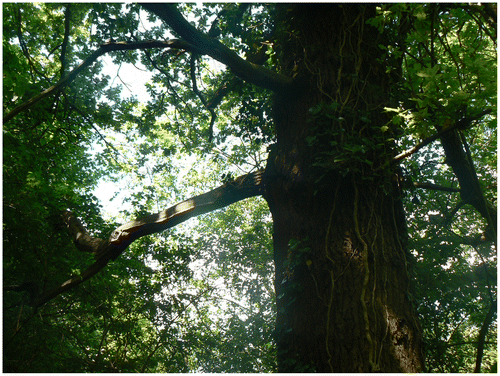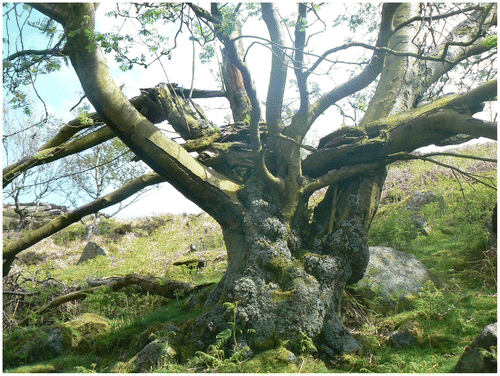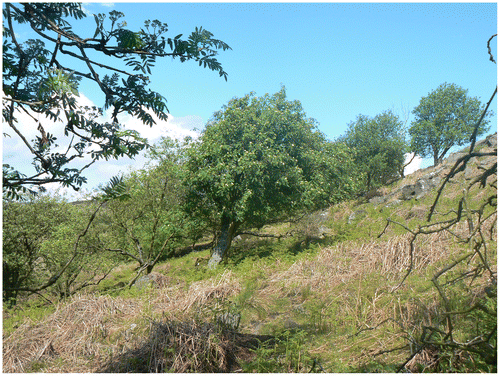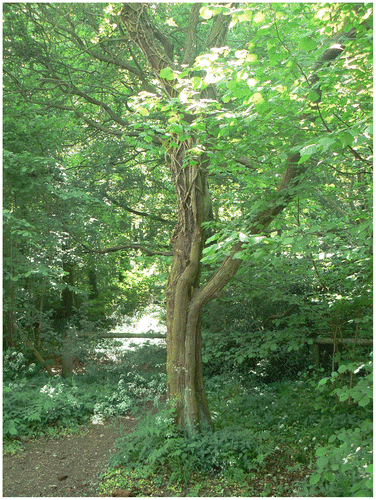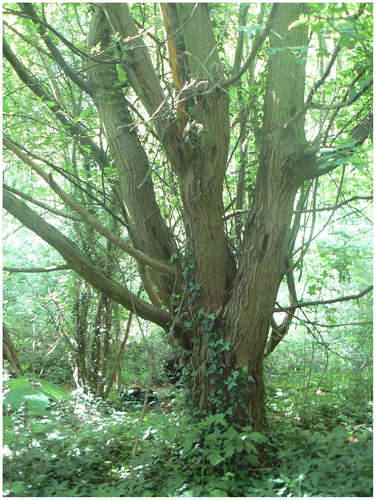A personal view of smaller veteran trees
Some years ago, on a field visit to Derbyshire’s Chatsworth Park, the late Oliver Rackham enthused about not the great old oaks but the smaller trees such as parkland hawthorns. Such specimens are frequently overlooked and undervalued; as Rackham pointed out, these smaller tree species can reach a great age but as most people expected old trees to be big they are ignored. Oliver’s observation and enthusiasm for smaller trees reinforced my own ideas and helped lead to the concept of the “shadow woods” described later in this volume (Rotherham, Citation2017). Obvious grand veterans occur at sites such as Chatsworth Park and other historic parklands, but other equally old trees have been dismissed as of little interest or significance.
Seeing old trees in the landscape
Essentially, in many places the old trees are all around us, yet frequently they are not obvious. Clearly tree size, growth rate, and even the processes of ageing and veteranisation vary with location and conditions, and with species. Some species simply do not attain great size as they mature, and also acquire veteran characteristics at a younger age. Other trees are in part shaped by human hand, what I call worked trees and this also affects the ageing process. These specimens are sometimes considered as working trees but now in their retirement years, former pollards, coppice stools, stubs and shreds are often relicts of times past.
We particularly overlook small veterans such as rowan or holly, and even birch, and it is often assumed that these species are short-lived. Yet in some circumstances, especially in upland or other stressed environments, these trees may attain an age of several centuries or more. Holly for example, can grow to considerable height as a standard tree in ancient woods but also reaches a great but indeterminate age as a clonal coppice stool. When site management occurs, such trees are rarely considered worthy of a second glance. Other commonly ignored but older trees include yew and even juniper, both often small for their age. Again overlooked by many conservation organisations and often in the planning process too, some fruit trees, (both domesticated and wild), may be old and long-lived. Pears in particular may grow to become significant veterans.
Some examples
Fieldwork in the Peak District has included detailed examination of pertinent specimens of rowan, birch and hawthorn. For example, an upland veteran rowan may show telltale signs of age:
| • | Large girth for the species with girth at one metre height between one and three metres; | ||||
| • | Major trunk cavities with significant and progressive hollowing of the main trunk; | ||||
| • | Decay holes and damp areas where water collects; | ||||
| • | Localised loss of bark and peeling of bark; | ||||
| • | Sap runs on the main trunk and major side branches; | ||||
| • | Crevices under stem bark and under branches or around the root plate especially where protected from direct rainfall; | ||||
| • | Major physical damage to the trunk; | ||||
| • | Evidence of fungal attack; | ||||
| • | Epiphytic plants; | ||||
| • | Evidence of beetle attack; | ||||
| • | Large amounts of dead standing wood in the canopy and fallen wood around the main tree. | ||||
All these features are typical signs of age and veteran status in deciduous trees and are abundant in the examined upland veteran rowans. Also, and typical of veteran trees, close-up examination reveals the “look” of an “old” tree with high aesthetic value and ecological richness. For example, the bases of these aged rowans are gnarled, bossed and covered by abundant epiphytic lichens; though only 10–15 m tall, these trees are clearly very old. Ring counts of lower main branches were between 70 and 110 years before hitting the rotted tissue in the core of the tree. Girths of two to three metres suggest anything between 150 years and 300 plus years old and for rowan such an age is ancient indeed. The main trunk of one particular specimen was certainly 250 years or more, though coring the main trunk revealed abundant rot beyond the most recent 110 years.
However, there is a further twist with trees that are culturally modified, and for rowan in particular, its cultural attachments become important. In some regions, especially in the north of England such as in Yorkshire or Derbyshire, these trees sometimes had special cultural significance as witching trees grown to protect livestock by warding off evil spirits. When they occur around abandoned upland farmsteads, this use may indicate considerable age. In this context, the side branch from a rowan deemed to require surgery to safeguard a stone-built sheep pen was ring-counted as about 150 years. Located close by a sheepfold at White Edge at around 1000 feet altitude on the Peak National Park Eastern Moors estate, this standard specimen was probably planted as a symbolic tree to protect livestock from evil. In some upland sites rowans are clearly culturally modified, managed as pollard or coppice for fuel. Some trees associated with archaeological features seem very old but further research is needed.
Holly may also reach a good age but again with limited size. Particularly in northern and western England it was managed in holly hags or hollins to provide herbage (winter-green leaf fodder) for cattle and especially in deer parks for deer. Management to produce the fodder was by either coppicing or by pollarding and this was mostly abandoned by the nineteenth century. Once released from such management, holly can spread clonally as rings of genetically identical standard trees. Some rings may be 1000 years or more in age and grow surprisingly tall standard trees from regrowths. Despite this antiquity, most woodland management considers them to be simply outgrown scrub of little conservation value. Some veteran hollies in upland areas especially, were exploited to produce “bird lime”; important in medieval and Victorian times for catching song birds for the pot (in medieval times) and for cage birds (in Victorian). The holly leaves were harvested and then buried in the ground to ferment. This process produced white sticky glue that was used to smear on tree branches and trap small birds. As in the case of rowan, old hollies mix ecological and historic or cultural significance.
There are four other trees to mention here, which are birch, hawthorn, hazel and willow (in this case sallow and hybrid Salix). Birch and hawthorn are both significantly overlooked as veteran trees but occur especially in upland and upland-fringe zones, and on lowland commons and heaths. Interestingly, birch is generally considered to be a very short-lived tree but this is not always the case. It is frequently coppiced or is self-coppicing in upland areas and managed trees can reach quite a size and age. Certainly most birch decline from about 80 to a 100 years, but many live much longer than this. However, quite how old these trees are remains to be established, but tree ring counts of main branches off the trunks of standard birches in the Peak District indicate that these split at least 120 to 130 years ago. This suggests that the main tree with a girth of, for example, 1.45 m, is at least 150–200 years old. Furthermore, there are rare occurrences of very old worked coppice trees much older. These rare specimens occur on former commons and remain to be fully assessed but are clearly very old.
On field visits to the Derbyshire Peak District, common hawthorn was singled out by Oliver Rackham as of particular interest. However, the trees found more recently are much older than those considered by Oliver. Again, like the old rowans these trees are not easy to age. Gnarled and convoluted beyond expectation for their size, the main trunks are rotted completely away to leave a ring of three to five main stems each with only an outer growth zone. Additionally, the hollowing appears to trigger a response of sending down new adventitious growths within the body of the old trunk. Initial ring counts indicate these outer shells with a total girth of about 1.75 m may be 50 to 70 years old but this is merely the recent growth and older material has rotted.
An observation at Whitwell Wood in North Derbyshire noted a veteran midland hawthorn in the ancient wood on Magnesian Limestone, as one of a group of full-canopy grown individuals with basal stools and multiple stems up to 20 m tall. The stool of the largest specimen was measured at 2.69 m girth with its biggest single re-growth 1.01 m. Close by was a common hawthorn with a single trunk around 15 m high with a girth of 1.21 m. On a nearby ancient wood boundary, stands a single standard hazel around 19 m high and 3.57 m girth at breast height. This is clearly a “tree” and not a “shrub” and brings to mind a lively debate on this topic between Oliver Rackham and Frans Vera at the 2003 Working and Walking in the Footsteps of Ghosts conference. The key question was whether hazel should be considered a tree or merely a shrub – and it is clearly a tree! However, whether it is an ancient coppice stool or a standard tree, hazel is another overlooked veteran.
Finally for now, another recently noted but often forgotten veteran species is the willow complex, and in this case, primarily the sallow/grey willow complex. Particularly in northern and western areas it seems that wet habitats in upland zones have some amazingly old willows. These specimens have been found as part of the “shadow woods” research reported later (Rotherham, Citation2017) and at present are undatable. There is anecdotal evidence of similar trees in Scotland being dated as many centuries old, but this remains to be verified. With a lack of recognition of the potential significance of such trees, there is pressure from site managers for them to be “thinned to allow regeneration”. This would of course obliterate any intrinsic conservation value in the venerable trees, and willow in a wetland will simply carry on growing out laterally and horizontal; there is no need for other regeneration beyond the natural cycle of the tree.
Recognition of the possible significance of all these veteran trees is a priority. When examined visually at close quarters, these trees have all the hallmarks of the veteran trees with which readers will be familiar. Yet they remain enigmatic and under-recorded, and so at risk. This is a subject where arboriculturists working in the wider landscape can make a major contribution to the science.
Contributions to this volume
Volume 39 Part 1 of the Arboricultural Journal brings you a major paper by Leers et al. (Citation2017) on the direct effects on street tree establishment, growth and development of atmospheric and re-radiated heat from surrounding surfaces. This radiation can adversely affect a tree through injury brought on by high temperatures. Resulting sunscald of tree tissues is symptomatic of direct heat injury to the plant and occurs on trunks and branches. Intense sunlight causes dehydration and death of these plant tissues. The study reported was designed to consider the impact on the establishment of roadside trees of various paving surfaces, tree orientation at the time of planting, with conditions of high ambient temperatures. The work was undertaken in Melbourne, Australia.
Rodney Helliwell (Citation2017), then presents the outcome of an extensive review of literature published in the Arboricultural Journal since its beginnings in 1965 until close to the present in 2015. He provides comments on some key topics, and delivers his perspective on the development of the subject of arboriculture over this period. In this context, Rodney considers the role of the journal today and into the future. Stretching back over this long period there were 163 issues of the journal. As the author notes, it was not possible to mention every single item or topic, and therefore, the selection is inevitably subjective and personal. However, whilst there may, as Rodney admits, “be some bias towards the subjects that have been of greatest interest to the reviewer or which appear to be of particular importance”, this is nevertheless a broad and wide-ranging commentary on 50 years of achievement.
Finally, Rotherham (Citation2017) presents a short Research Note on current developments in the search for “Ghost Woods” and “Shadow Woods” in the landscape. This work is helping to unravel the complexities of woodland histories and tree stories in the evolution of the British countryside.
Editor, Arboricultural Journal
[email protected]
References
- Helliwell, R. (2017). 51 years of the Arboricultural Journal: A commentary. Arboricultural Journal, 39, 9–23.10.1080/03071375.2017.1269488
- Leers, M., Moore, G. M., & May, P. B. (2017). The effects of paving surfaces and planting orientation on street tree growth and trunk injury. Arboricultural Journal, 39, 24–38.10.1080/03071375.2017.1279426
- Rotherham, I. D. (2017). Searching for “shadows” and “ghosts” in the landscape. Arboricultural Journal, 39, 39–47.

